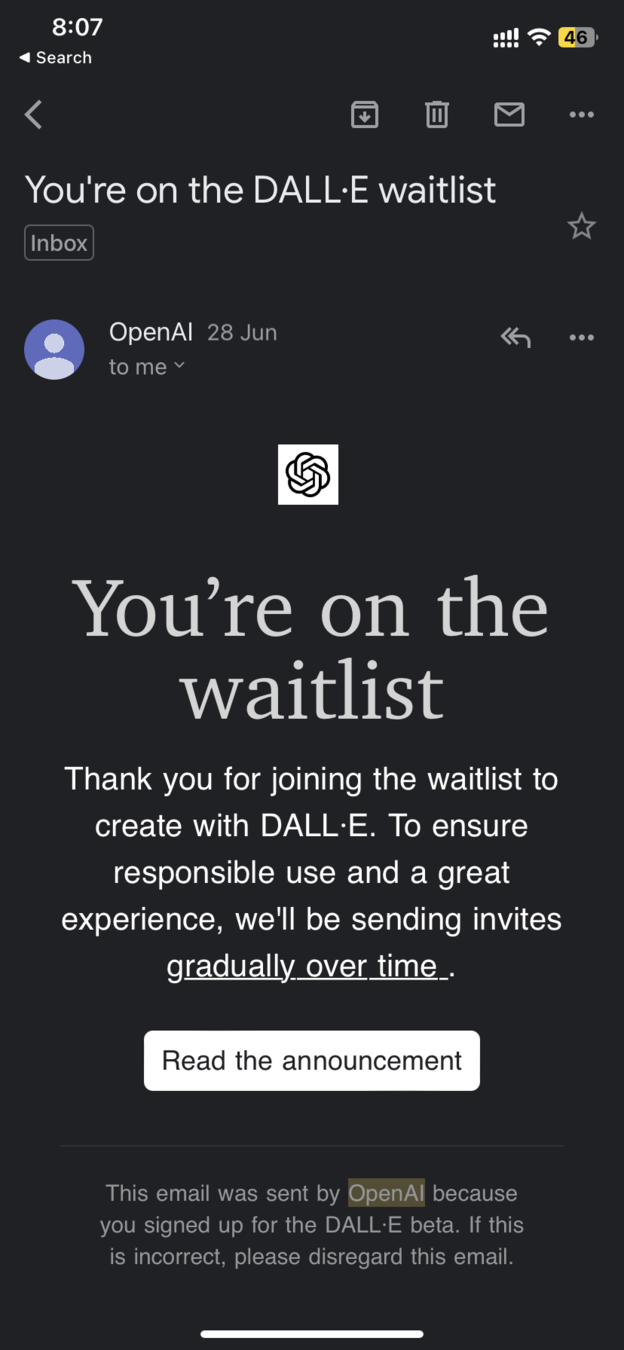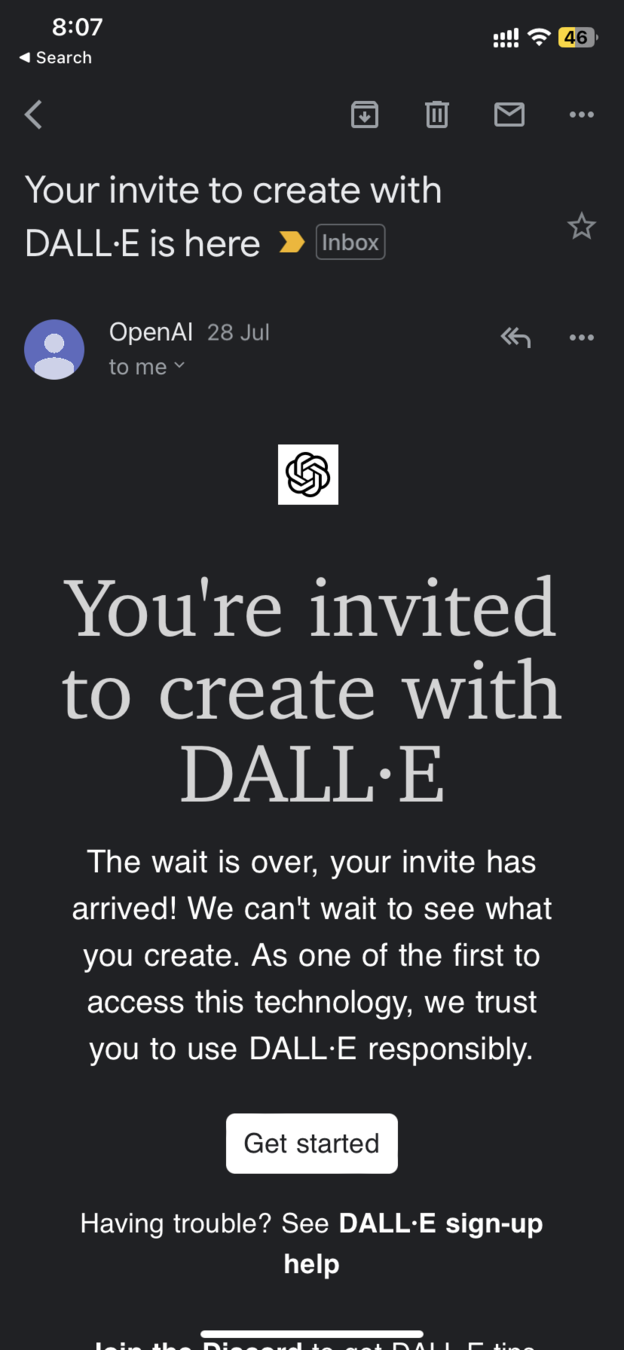
Ana Pintar

UX Strategist

Yash Parmar
UI/UX Designer

The Behavioral Design Behind
8 min read / Onboarding Adoption / AI

DALL·E 2



Case Study Overview
You will learn about product adoption techniques based on behavioral science to increase user engagement.
This includes exploring how to effectively apply the following behavioral principles:
1. Suggestion
2. Labor Illusion
3. Variable Reward
4. Surprise element


It was a nice Saturday morning when I got introduced to a new AI tool that can create images from "descriptions in natural language."





“Okay, let’s try this magic out” I thought to myself.







So, what is DALL·E 2? It's a text-to-image generator AI software made by Open AI. Upon signing up, you receive 15 free credits to generate or modify images based on your text descriptions. It seemed pretty cool.




I registered and waited for my account to be approved.






It took 1 Month... But once I finally received the DALL-E invite, I jumped to use the tool straight away! I was ready to begin my AI image journey.









I started experimenting with all kind of weird text prompts, and in just 20 minutes I had used ALL my credits. I got hooked.



Want to know how they got me hooked?
Then read on. Let the treasure hunt begin.🧠






This is what I saw when I entered DALL·E.
Clearly, they want me to generate images.




As a first-time user, I appreciate their suggestion for a good description to use for generating an image since I have no idea what would work best.



1. Suggestion
Giving suggestions to help people learn how to use the product



They are giving me a suggestion, which is great because as a first time user I have no idea what a good description for generating image would be.


1. Suggestion
Giving suggestions to help people learn how to use the product
-
Offer suggestions for action at the right moment in the right context.
-
The right moment for persuasion is known as Kairos, and it occurs when people are in a good mood, able to act immediately or have a shift in perspective."
-
Example in a digital world: For example, a digital speed monitoring radar could remind a driver to reevaluate their driving behavior if they are going too fast.
-
Example in a physical world: A mobile application suggesting you to exercise today
-
DALL·E: Providing contextual advice on how to search for images in the context.



Let’s try by typing a random sentence...





Oh … loading bar and a pro tip.

1. Suggestion

2. Labor Illusion



Oh … loading bar and a pro tip.

2. Labor Illusion
Users perceive products better if they know how much effort was put in.
-
To increase the perceived value of your product or service, emphasize the effort and work you put into it, or highlight any special techniques or technology you use to help customers appreciate and value it more. Often, we have trouble determining the intrinsic quality of a product or service, so we use time or effort as a proxy for value.
-
Example in a digital world: Tinder uses an intermediate screen that says 'finding potential matches' to make users feel like the app is putting effort into finding them a good match.
-
Example in a physical world: Restaurants can increase value by showcasing features like open kitchens and highlighting the freshness of ingredients like the distance the fish had to travel.
-
DALL·E: Displaying a load screen before showing results can increase user trust and value in a brand by demonstrating that the platform is doing work and putting effort in it, to find relevant results.



This is what I got...
How awesome is that!





Let’s try this again.





and again...





and again.........



3. Variable Rewards



And again..............



3. Variable Rewards
People repeat behaviours that are rewarded.
This principle is related to present bias, which depicts we generally favour a smaller gain in the short run over a larger gain in the future. In other words, we overvalue immediate rewards.
Resource: Hooked by Nir Eyal (2014)





And again..............



There are 3 types of variable rewards:
1. Rewards of the tribe
... is a social reward, inflamed by connecting with other people, so we feel accepted, attractive, important and included. Gratification from others.
Example:
Users can earn badges and privileges on Stack Overflow by accumulating points through upvotes on their answers.




And again..............



There are 3 types of variable rewards:
1. Rewards of the tribe
... is a social reward, inflamed by connecting with other people, so we feel accepted, attractive, important and included. Gratification from others.
Example:
Users can earn badges and privileges on Stack Overflow by accumulating points through upvotes on their answers.

2. Rewards of the hunt
... are searching for valuable assets (e.g. resources, information, coupons or even a physical item).
Example:
When browsing through social media, people often seek out relevant pieces of information as they scroll through an seemingly endless feed.




And again..............



There are 3 types of variable rewards:
1. Rewards of the tribe
... is a social reward, inflamed by connecting with other people, so we feel accepted, attractive, important and included. Gratification from others.
Example:
Users can earn badges and privileges on Stack Overflow by accumulating points through upvotes on their answers.

2. Rewards of the hunt
... are searching for valuable assets (e.g. resources, information, coupons or even a physical item).
Example:
When browsing through social media, people often seek out relevant pieces of information as they scroll through an seemingly endless feed.
3. Rewards of the self
... is an intrinsic reward we seek for personal gratification (achieving proficiency, unlocking a badge, mastery completion), so we feel proficient
Example:
In games where players level up and unlock special powers, or in language learning apps like Duolingo, where users are awarded badges for reaching milestones or completing certain actions.





DALL·E is designed to provide a variable reward every time you use the search field. When you type in a query, you will be presented with a selection of images that may make you laugh, feel surprised, or learn something new.




This is the beauty of generative AI: it's pretty random! While not all product might have this principle so clearly built into its core offering, it's still a valuable lesson to remember.



I’m wondering what this surprise button does. Okay DALL·E, show me what you got.





That’s marvelous.


4. Suprise element!




That’s marvelous.


4. Surprise element
Surprise element activates the brain's reward system.
Incorporating elements of surprise into product design can be a useful way to engage and retain users. By providing unexpected rewards or novel experiences, a product can create a feeling of excitement and enjoyment for the user, which can drive repeat usage and increase customer loyalty.
Example in the physical world: "Mystery box" subscription service, in which the customer pays a fee to receive a box of surprise products on a regular basis.
Example in digital world: A social media platform that includes a "throwback" feature that randomly resurfaces old posts for users. Also, if you read HW newsletter then you might think of another example. 😉
DALL-E: The element of surprise in the DALL-E search engine, when seeing the images that appear in response to a search, may encourage users to keep using the search engine to find more unexpected rewards.




The most important thing is that at the end you always get something surprising. This unexpectedness makes DALL-E a great example of a habit forming product.



Before wrapping-up, it's worth noting that there are other AI image generators. Remember those Tesla's from DALL-E? Here's me using the same prompt, but with Midjourney 4 🤯







Congratulations! Case study completed ✅
Let’s review what behavioral principles we have learned that might help you with boosting your product adoption.











Final takeaways 🧠

1. Suggestions
-
Offer users a suggestion on what to do with your product. In the right time, in the right context.
-
Example, just like DALL-E does when you land on the landing page.
2. Labor illusion
-
Show users how much effort you are putting into a certain action. This can increase both trust and anticipation.
-
Example, DALL-E loading bar.
3. Variable reward
-
Find playful ways to reward user's behavior.
-
Example, DALL-E providing a variety of images with each query.
4. Suprise
-
Incorporate surprise elements to activate users brain reward system, engage and retain them.
-
Example, just like DALL-E is doing with “Surprise me” button.






1. Suggestions
-
Offer users a suggestion on what to do with your product. In the right time, in the right context.
-
Example, just like DALL-E does when you land on the landing page.
2. Labor illusion
-
Show users how much effort you are putting into a certain action. This can increase both trust and anticipation.
-
Example, DALL-E loading bar.
3. Variable reward
-
Find playful ways to reward user's behavior.
-
Example, DALL-E providing a variety of images with each query.
4. Suprise
-
Incorporate surprise elements to activate users brain reward system, engage and retain them.
-
Example, just like DALL-E is doing with “Surprise me” button.

As a bonus gift, I've also created a cheat sheet you can download.

What did you think about this case study? Let us know so we could improve!




You know... Sharing is Caring
How ‘bout your friends know this Information too. Click & Share.


x7

x11

Insta DM
x23



Creators of this Case-Study
